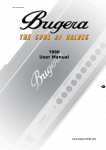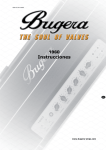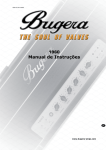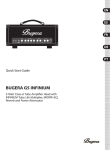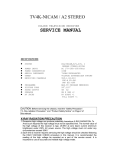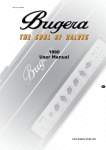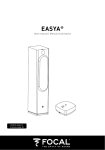Download SE Microphone User Guide
Transcript
User’s Guide for Tube Microphones Sonic Distribution USA 27 Gilman Ter, Ste 1 Somerville, MA 02145 Phone: 617-623-5581 E-mail: [email protected] Tube V1.0 5/07 Microphone User’s Guide INTRODUCTION................................................................................................ 2 CARE AND USE OF MICROPHONES.............................................................. 2 GENERAL ......................................................................................................... 2 SAFE USE OF HIGH VOLTAGE TUBE MICROPHONES ............................................. 2 TUBE REPLACEMENT......................................................................................... 2 OPERATING ENVIRONMENT AND STORAGE......................................................... 3 CLEANING ........................................................................................................ 3 WARRANTY ...................................................................................................... 3 COMMON PROBLEMS AND SOLUTIONS .............................................................. 3 MICROPHONE MODELS: ................................................................................ 4 GEMINI II ......................................................................................................... 4 Z5600A II....................................................................................................... 5 ICIS................................................................................................................. 6 POLAR PLOTS AND FREQUENCY RESPONSE GRAPHS:............................ 7 GEMINI II ......................................................................................................... 7 Z5600A II....................................................................................................... 7 ICIS................................................................................................................. 8 NOTES ON RECORDING ................................................................................. 8 POLAR PATTERNS ............................................................................................ 8 USING VARIABLE PATTERNS ON THE Z5600A II................................................ 9 USER NOTES ..................................................................................................10 1 Microphone User’s Guide Introduction This manual was prepared by Sonic Distribution USA LLC to be used in conjunction with sE Electronics products. Congratulations on purchasing your new sE microphone! Used with care, it will provide you with many years of reliable service. By combining the expertise of manufacturing and design engineers with the listening skills of musicians, sE is able to produce mics that give exemplary audio performance in a variety of recording situations. sE is a US company with its own manufacturing facility in Shanghai, China, ensuring affordable prices and a high level of technical performance. sE does not buy or sell microphones from or to other companies. If it doesn't say sE on the mic, it is not an sE microphone! Every sE mic is designed from the ground up to fill a specific need and is assembled using high quality parts. All mics are built in a modern manufacturing facility that uses the latest precision machines in combination with a skilled and specially trained assembly staff. Care and Use of Microphones General Most of the operational requirements of this microphone follow common sense practice for electrical devices in general. Do not operate the mic in excessively damp environments or where accidental contact with water is a possibility. Do not use solvent based products to clean it as the finish may be damaged. Always ensure that the electrical system into which the microphone is plugged is grounded in compliance with the local electrical wiring code. Condenser microphones are precision instruments and may become damaged if dropped onto a hard surface. In case of such damage, please contact an authorized sE service agent. Attempting to repair the microphone yourself or any attempted repair by a non-authorized service agency will void the warranty. Safe Use of High Voltage Tube microphones All sE tube mics operate at high voltages to supply optimum power to the tubes. The power supply must always be connected with the included power cable to a properly grounded outlet. NEVER attempt to open the mic or power supply when they are connected to power as contact with the voltage inside could be fatal. Tube Replacement With proper care and use, the tube in your sE microphone should provide you with many years of optimal performance. If you feel that your microphone is losing sonic performance, it may be time to replace the tube. NEVER attempt to replace a tube while the mic is connected and be careful when handling tubes as they can be hot after use. Unscrew the base of the microphone and carefully slide the body off. Gently remove the old tube from the socket and replace with a new one. Reassemble the body. 2 Microphone User’s Guide All sE tube microphones use an ECC83A (popularly regarded as a low noise, low microphonic 12AX7). The Gemini II also has an ECC82 (12AU7) tube, which provides an actively balanced output. We recommend using only sE Electronics tubes. Damage to the microphone caused by using tubes other than the recommended types will not be covered by the warranty. Contact Sonic Distribution for replacements. Operating Environment and Storage All condenser microphones are susceptible to a short term loss of performance if they are exposed to moisture. Store your microphone at a sensible room temperature and always use it with a pop screen when recording vocals. In addition to preventing popping on plosive “B” and “P” sounds, a pop screen will help keep moisture away from the diaphragm. If your microphone becomes noisy (a “rumble” sound) or loses sensitivity because of exposure to moisture, simply put it somewhere warm and allow it to dry out for a few hours. Its performance should return to normal. It is also recommended that all condenser microphones be used in a non-smoking environment as smoke deposits can build up on the diaphragm over time. This can result in a loss of performance that can only be remedied by professional cleaning. It is highly recommended that you keep the microphone in its included cases when not in use. Cleaning If the microphone body requires cleaning, use a damp cotton cloth with a little mild detergent and then dry the microphone body thoroughly. Never let water get into the grille protecting the capsule and never spray cleaning products or contact enhancing products where they could come into contact with the capsule as irreparable damage could be caused. Warranty For information regarding your warranty, please refer to the included warranty card. Common Problems and Solutions Shockmount will not fit on my stand: Remove the brass thread reducer. Distortion or clipping when recording loud sources (drums, guitar amps, etc.): Engage the -10dB pad when available. If not, the microphone may need to be moved further from the source. Low frequency distortion Engage the hi-pass filter ( ) when available. 3 Microphone User’s Guide Microphone Models: Gemini II The Gemini II is a one-of-a-kind, no holds barred piece of microphone history. The dual tube design means pure tube warmth from an ECC83A input tube coupled with an ECC82 tube on the output stage in place of the traditional transformer. The result: an incredibly large, detailed and intimate sound reminiscent of the classic tube microphones from decades ago. Operation Connect the microphone to the power supply using the 8-pin cable and tighten the fasteners on both ends. Connect the power supply to a grounded outlet using the 3-pin power cable. Use a standard 3-pin XLR to XLR cable to connect the power supply to your preamp and turn it on, ensuring your monitors are turned off or muted. It is recommended that you let the microphone warm up for a minimum of 30 minutes before use. For standard low frequency response, use the --------- setting. To attenuate frequencies below 100 Hz – reducing rumble or other low frequency sounds – engage the setting. When micing louder sound sources, you may want to engage the -10dB pad to prevent distortion or clipping of the microphone. Suggested Applications: • Vocals • Saxophone and trumpet • Acoustic guitar • Drums – especially for ambient micing Specifications Frequency response 20 Hz – 20 kHz Polar pattern Cardioid Features: • 1.07” gold-sputtered diaphragm • Dual tube design, transformerless • Cardioid polar pattern • -10dB Pad, 100 Hz Roll Off switches Max SPL 135 dB for THD 0.5% Sensitivity 12.6mV/Pa - 38 ± 1dB Accessories included: • Aluminum flight case and wood display case • Locking shock mount • Power supply unit • High quality 8-pin army cable Polar Plot and Frequency Response: See page 7 4 Rated impedance < 200 Ohms Equivalent Noise Level 16dB (A weighted) Power source External power supply Microphone User’s Guide Z5600a II The Z5600a II is an incredibly versatile tube condenser and one of the best vocal mics in today’s market. Featuring 9 polar patterns with 6 graded steps between cardioid, omni, and figure 8, the Z5600A II easily finds uses in a huge number of applications. Above all, this excellent mic has won its praise on delivering a superb vocal recording with natural warmth and incredible detail on instruments. Operation Connect the microphone to the power supply using the 8-pin cable and tighten the fasteners on both ends. Connect the power supply to a grounded outlet using the 3-pin power cable. Use a standard 3-pin XLR to XLR cable to connect the power supply to your preamp and turn it on, ensuring your monitors are turned off or muted. It is recommended that you let the microphone warm up for a minimum of 30 minutes before use. For standard low frequency response, use the --------- setting. To attenuate frequencies below 100 Hz – reducing rumble or other low frequency sounds – engage the setting. When micing louder sound sources, you may want to engage the -10dB pad to prevent distortion or clipping of the microphone. You may also select between 9 polar patterns using the switch located on the power supply. For more information about the different polar patterns and their applications, see pages 8 & 9. Suggested Applications: • Vocals • Drums – especially overheads • Piano • Acoustic guitars Specifications Frequency response 20 Hz – 20 kHz Features: • Dual 1.07” gold-sputtered diaphragm • 9 selectable polar patterns • ECC83A tube for a warm, detailed sound • -10dB Pad, 100 Hz Roll Off switches Accessories included: • Aluminum flight case and wood display case • Locking shock mount • Power supply unit with polar pattern switch • High Quality 8-Pin army cable Polar Plot and Frequency Response: See page 7 5 Polar pattern 9 selectable on power supply Max SPL 130 dB for THD 0.5% Sensitivity 14.1mV/Pa - 37 ± 1dB Rated impedance < 200 Ohms Equivalent Noise Level 16dB (A weighted) Power source External power supply Microphone User’s Guide ICIS The ICIS offers beautiful looks, great design, and exceptional sound at an incredible price. It is the only microphone in the sE line to feature our 1.07” edge-mounted diaphragm. Everything about the ICIS is designed to capture the heart and warmth of a performance, while maintaining a truly detailed vocal take. The silkier top end makes the ICIS a stand out performer for use on soprano and high tenor voices while it also attractively captures sibilant sources. Operation Connect the microphone to the power supply using the 8-pin cable and tighten the fasteners on both ends. Connect the power supply to a grounded outlet using the 3-pin power cable. Use a standard 3-pin XLR to XLR cable to connect the power supply to your preamp and turn it on, ensuring your monitors are turned off or muted. It is recommended that you let the microphone warm up for a minimum of 30 minutes before use. Suggested Applications: • Vocals – especially female and rock tenors • Saxophone • Electric guitar Features: • 1.07” edge-mounted diaphragm • Cardioid polar pattern • ECC83A tube for a warm, detailed sound Accessories included: • Aluminum flight case and wood display case • Locking shock mount • Power supply unit • High Quality 8-Pin army cable Polar Plot and Frequency Response: See page 8 Specifications Frequency response 20 Hz – 20 kHz Polar pattern Cardioid Max SPL 135 dB for THD 0.5% Sensitivity 14.1 mV/Pa - 37 ± 1dB Rated impedance < 200 Ohms Equivalent Noise Level 16dB (A weighted) Power source External power supply 6 Microphone User’s Guide Polar Plots and Frequency Response Graphs: Gemini II Z5600a II 7 Microphone User’s Guide Polar Plots and Frequency Response Graphs (continued): ICIS Notes on Recording Polar Patterns The polar pattern of a microphone refers to the direction or directions in which it picks up sound. Some microphones are a fixed single pattern (usually cardioid) while others offer the ability to switch between multiple patterns. When using a multipattern mic, it is always a good idea to experiment with different patterns not only for different directional characteristics but also for tonal variations. Here are descriptions of 4 basic and common polar patterns. Cardioid Picks up sound from the front and sides of the microphone with good rear rejection. Exhibits proximity effect. Figure 8 Picks up sound from the front and back of the microphone with good side rejection. Exhibits maximum proximity effect. Omnidirectional Picks up sound from all directions. Exhibits no proximity effect. Hypercardioid Like cardioid with more rejection on the sides, less rear rejection and more proximity effect. Note: Proximity effect refers to an increase in low frequency pickup as the source is moved closer to the microphone, typically within a 2 ft range. 8 Microphone User’s Guide Using Variable Patterns on the Z5600a II The rotary control switch on the Z5600a II power supply gives you complete control over the microphone’s 9 available polar patterns. By adjusting this control, you can alter the ambience and spaciousness of the captured source as well as the low end response (proximity effect). Directionality – Starting with the rotary control set completely clockwise, your Z5600a II will pick up sound from all directions in an omni polar pattern. The next three positions in the counter-clockwise direction will progressively become more like a cardioid pattern, rejecting more sound from behind the microphone. The center position of the switch yields a true cardioid pattern. The next three positions counter-clockwise after cardioid will progressively become more like a figure 8 pattern, rejecting more sound from the sides and picking up more in the front and rear of the microphone. Proximity Effect – In the omni polar pattern, the microphone will exhibit no proximity effect. As you turn the switch towards figure 8, the proximity effect will increase. This is an extremely useful feature that allows you to add or subtract low end response from sources that are recorded close to the microphone. For example, if you’re recording a vocal in cardioid and it sounds “thin”, try adjusting the pattern a few positions towards figure 8. It may give you that extra “oomph” you’re looking for! For more recording techniques and applications, please visit our website: http://www.sonicus.net/ 9 Microphone User’s Guide User Notes: 10











